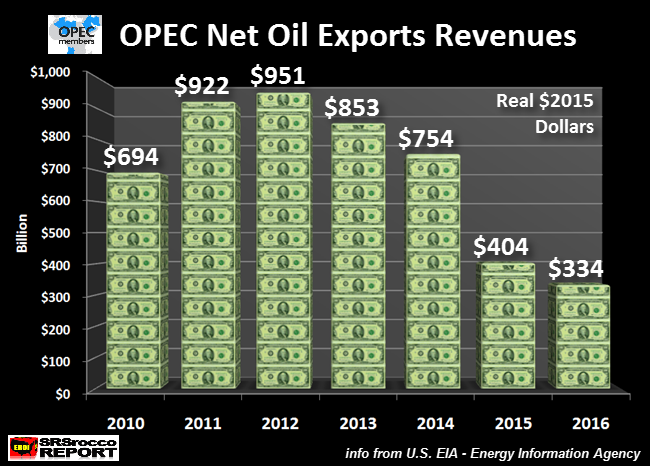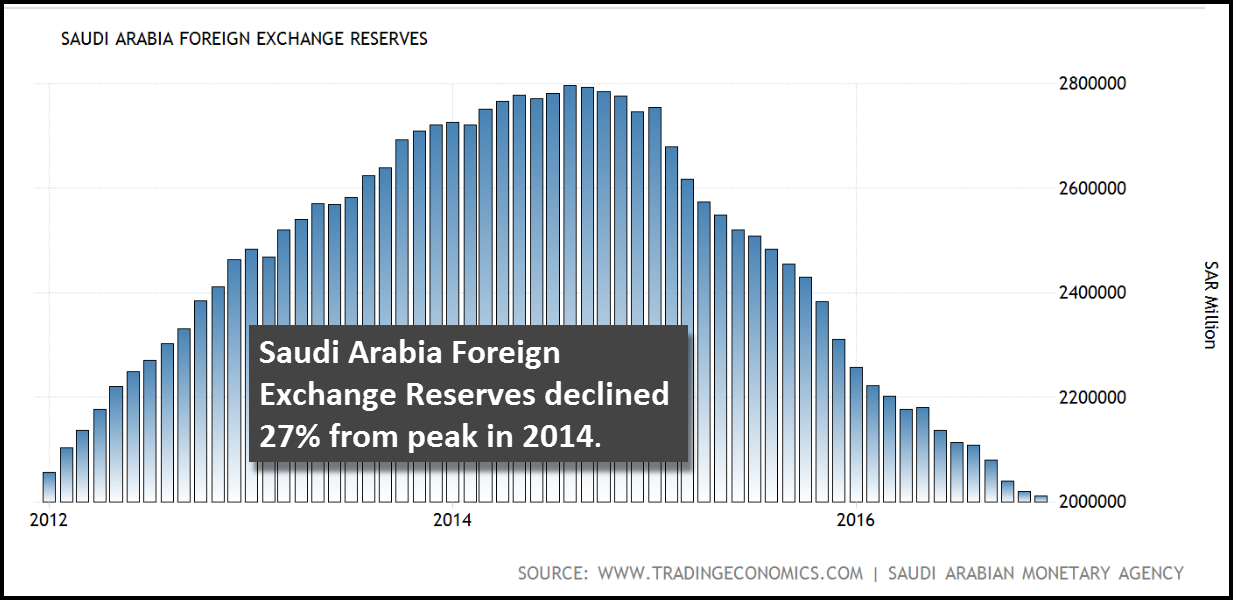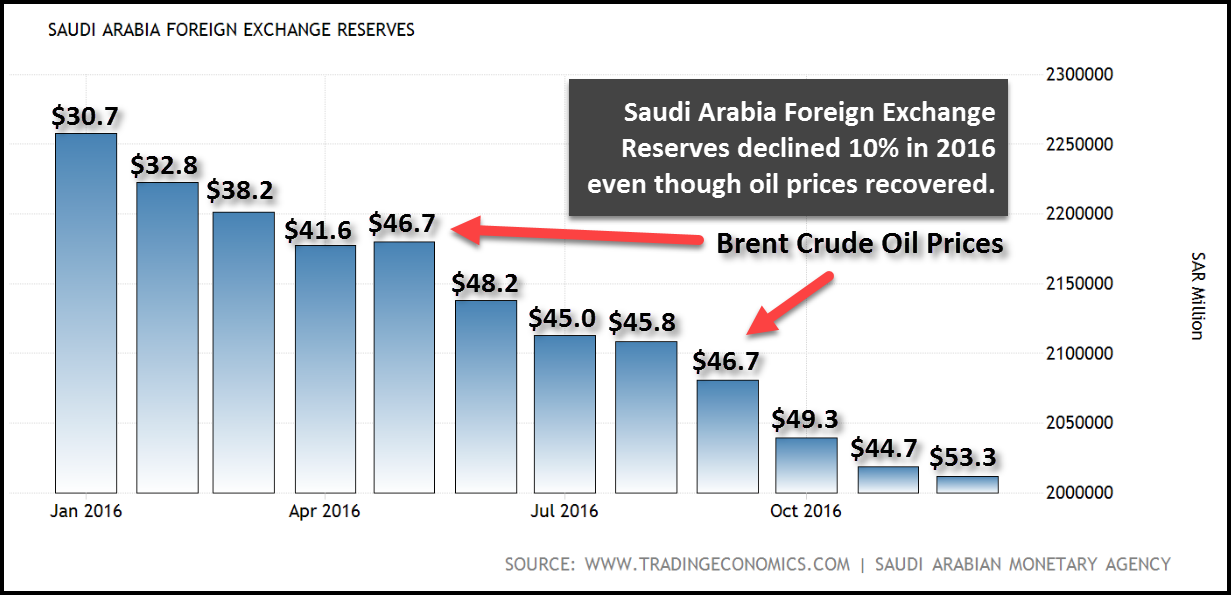Bankrupting OPEC... One Million Barrels Of Oil At A Time
The world hasn’t really caught on yet, but OPEC is in serious trouble. Last year, OPEC’s net oil export revenues collapsed. How bad? Well, how about 65% since the oil price peaked in 2012. To offset falling oil prices and revenues, OPEC nations have resorted to liquidating some of their foreign exchange reserves.
The largest OPEC oil producer and exporter, Saudi Arabia, has seen its Foreign Currency reserves plummet over the past two years… and the liquidation continues. For example, Saudi Arabia’s foreign exchange reserves declined another $2 billion in December 2016 (source: Trading Economics).
Now, why would Saudi Arabia need to liquidate another $2 billion of its foreign exchange reserves after the price of a barrel of Brent crude jumped to $53.3 in December, up from $44.7 in November?? That was a 13% surge in the price of Brent crude in one month. Which means, even at $53 a barrel, Saudi Arabia is still hemorrhaging.
Before I get into how bad things are becoming in Saudi Arabia, let’s take a look at the collapse of OPEC net oil export revenues:

The mighty OPEC oil producers enjoyed a healthy $951 billion in net oil export revenues in 2012. However, this continued to decline along with the rapidly falling oil price and reached a low of $334 billion in 2016. As I mentioned before, this was a 65% collapse in OPEC oil revenues in just four years.
The last time OPEC net oil export revenues was this low was in 2004. OPEC oil revenues that year were $370 billion based on average Brent crude price of $38.3. Compare that to $334 billion in oil revenues in 2016 on an average Brent crude price of $43.5 a barrel.
This huge decline in OPEC oil revenues gutted these countries foreign exchange reserves. Which means, the falling EROI- Energy Returned On Investment is taking a toll on the OPEC oil exporting countries bottom line. A perfect example of this is taking place in Saudi Arabia.
Saudi Arabia was building its foreign exchange reserves for years until the price of oil collapsed, starting in 2014. At its peak, Saudi Arabia held $797 billion in foreign currency reserves:

(note: figures shown in SAR- Saudi Arabia Riyal currency)
In just two and a half years, Saudi Arabia’s currency reserves decline a stunning 27%, or approximately $258 billion (U.S. Dollars) to $538 billion currently. What is even more surprising, is that Saudi Arabia’s foreign currency reserves continue to decline as the oil price increased towards the end of 2016:

The BLUE BARS represent Saudi Arabia’s foreign exchange reserves and the prices on the top show the average monthly Brent crude price. In January 2016, the Brent crude oil price was $30.7 a barrel. However, as the oil price continued to increase (yes, some months it declined a bit), Saudi’s currency reserves continued to fall.
Matter a fact, Saudi Arabia liquidated approximately $78 billion of its foreign currency reserves in 2016. I checked out Saudi Arabia’s oil exports at the JODI – Joint Organizations Data Initiative for the past year. Saudi’s average oil exports for the year was 7.7 million barrels per day.
By multiplying that figure by 365 days, Saudi Arabia exported approximately 2.8 billion barrels of oil in 2016. That’s one hell of a lot of oil.
Okay… so why did Saudi Arabia need to liquidate $78 billion of its foreign currency reserves in 2016? Well, according to the U.S. EIA – Energy Information Agency, Saudi Arabia’s net oil export revenues were $130 billion in 2015. Assuming a 17% drop in the price of oil in 2016, that would suggest that Saudi Arabia’s export oil revenues also fell approximately 17% in 2016 to $108 billion.
Saudi’s oil export revenues of $108 billion are 65% less than the $307 billion it received in 2012. Again, this low oil price is seriously gutting Saudi Arabia’s balance sheet.
Unfortunately, things may get even worse for the House of Saud. According to the article, Saudi Arabia’s Social Stability To Fall Apart:
Geopolitical Futures’ George Friedman has warned that Saudi Arabia’s inability to keep oil prices up to $90 a barrel will frustrate the kingdom’s effort to balance its books, meaning it is only a matter of time before “Riyadh’s unique social stability comes apart.”
To balance its books, Saudi Arabia needs the price of oil to be $90, versus the current $54 per barrel. Despite the kingdom being “engaged in a number of measures towards adjusting political economy to accommodate low oil prices,” Riyadh has blown through 27 percent of its foreign exchange reserves,” which hit $535.9 billion as of October – a $10 billion drop from the prior month.
Furthermore, with the biggest U.S. gasoline glut in 27 years, on top of a record concentration of long positions in crude oil, the price of oil will likely head much lower… and this is not good news for the Kings running the show in Saudi Arabia.
Once the lousy economic fundamentals finally kick in and give the broader stock markets one heck of a serious ENEMA, watch out… the price of oil could really fall. Of course, the Fed and Central Banks could step in and do something really STOOPID, but this will only postpone the inevitable a little longer.
According to The Hill’s Group and Louis Arnoux’s work, the thermodynamics suggests that the market will continue to experience falling oil prices over the next 5-10 years. Even though there could be some volatility, the oil price will trend lower because the net energy available to market will continue to fall as well.
This will be a disaster for Saudi Arabia and the other OPEC oil exporting nations. Keep an eye on the oil price. If it continues to fall, well then…. I suggest owning STOCKS, BONDS or REAL ESTATE may come with a great deal of pain and suffering.
Disclosure: None.




thanks for sharing